By Hardy Oelke
(For further information on a specific topic please click on the highlighted text)
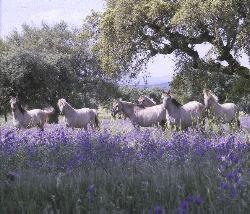 This group of Sorraias lived practically wild on a large estate of one of the d'Andrade grandsons until 1999. They are now managed to a degree. Photography by Hardy Oelke |
When the
Sorraia horse was discovered in 1920, few could
believe that a wild horse subspecies could have survived that long in Europe. A
few decades earlier, the Mongolian wild horse had
been all but wiped out, with just a few specimens saved in zoological gardens,
and the East European Tarpan had become extinct even
earlier. There were already zoologists ready to deny the Tarpan the status of a
true wild horse, just because they hadn't had a chance to study and
scientifically describe the Tarpan before he vanished forever. Zoologists had
ignored him until it was too late. |
They were going to do the same with the Sorraia, even though the Portuguese scientist who discovered this horse, Ruy d'Andrade, did his level best to study the Sorraia, preserve him, and make the zoological community aware of him. In this respect the Sorraia shares his fate with the English Exmoor pony: although significant evidence exists for the Exmoor to be not a man-made breed, but a remnant of an ancestral wild horse, many, if not most, zoologists wouldn't want to hear of it. Wild horses in our civilized Europe? Come on!
When the last specimen of the Mongolian wild horse were discovered and captured, it was a totally different issue - the Mongolian steppes were far enough removed that European scientists would take interest in these horses and accept that they were indeed not just wild-living horses, but wild horses in the zoological sense.
Going back to the Sorraia, it must be noted that Iberia was largely ignored by zoologists in other European countries. The vast expanses of Russia and Asia held an allure that smelled of discoveries and potentials. They automatically also looked for the cradle of domestication there, and to this day the hints, and even evidence, for the first domestication of the horse to have taken place in Iberia can hardly be found in scholarly works.
The reason wild horses could survive in the lowlands of the Sorraia river was that the area used to be a fairly unaccessible wilderness which served as a hunting ground for the Portuguese Royalty until the early 1900s. It was on a hunting trip there that Ruy d'Andrade happened to see a band of the wild horses he later named "Sorraia", after the river. He later tried in vain to relocate that herd, but found horses of the same phenotype in several places in the general area of the Sorraia river. As a zoologist and paleontologist, he finally decided he had stumbled on an ancestral type of horse, and that it needed to be preserved. He acquired seven mares that possessed the characteristics he considered typical according to his studies, and left them to fend for themselves on his property, which fortunately was large enough for such a project. He tried four different stallions on them. His theory was that living wild, without the help of man, in their own habitat, would result in Mother Nature's purifying the small population, and bringing out and consolidating their original characteristics and abilities.
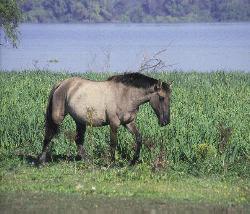 This is a Lusitano mare, roaming a pasture at river Tejo, which shows such strong Sorraia characteristics that at first glance she could be mistaken for a Sorraia. Photography by Hardy Oelke |
Ruy d'Andrade
found out that the Sorraia exhibits some strong similarities with the Lusitano,
Andalusian, and Barb horse. It was especially the teeth, the molars in
particular, which he studied and found to be the same in the Sorraia as well as
the above mentioned breeds, and quite different from other horse breeds. The
general build of the skull is also similar in the Sorraia and
Lusitano/Andalusian, and different from other breeds. D'Andrade concluded that
the Sorraia is the wild ancestor of the Andalusian and Lusitano. |
Today's whole Sorraia population goes back to those seven mares of Ruy d'Andrade's, and the four stallions he employed, although they were eventually narrowed down to only one direct paternal line. The inbreeding they have thus been forced to suffer is tremendous, and any man-made breed would long have succumbed to it. However, if the Sorraia has suffered any ill effects, it doesn't show - Sorraias are still very hardy, fertile, able to live off the most meagre feed the land has to offer, surviving without barns and the help of man.
| In the Sorraia, we still have a primitive horse of South Iberia, thanks to the efforts of Ruy d'Andrade. With the benefit of modern technologies, namely DNA analysis, we have a bit more insight though in any ancestral role the Sorraia may have played. It isn't quite as simple and clear-cut as d'Andrade saw it, but this technology did confirm that he indeed singled out and preserved a horse of singular status, and an invaluable genetic resource at that. | 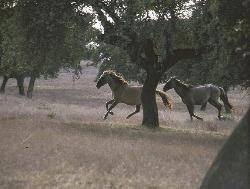 Some Sorraia mares in a pasture typical for Portugal - studded with cork oak and live oak and sometimes olive trees. Photography by Hardy Oelke |
Interview with Hardy Oelke
Q: How and why did you become involved in the protection of the Sorraia horse?
A: Besides training, riding, and showing horses, I've always been interested in primitive horses. So I had known of the Sorraia when I stumbled across certain American mustangs in the early 90s which I thought looked a lot like Sorraias. I felt they might represent a valuable offshoot of the Sorraia and needed to be preserved, but in order to be sure, I had to study the Sorraia first-hand. Going to Portugal and doing so, I became convinced that these mustangs had to be directly related to the Sorraia and have been able to prove that; I also couldn't help but notice the circumstances under which the remaining Sorraias live there. Ever since I've tried to find a solution to ensure the Sorraia's survival as a primitive, ancestral horse.
Q: You say the relatedness of the Sorraia and some mustangs were proved - how was that done?
A: In order to establish such a relatedness - which seemed likely due to strong phenotypic similarities - I took hair samples of a number of Sorraias and also of many mustangs of different strains. I had those analysed by a German institute. The state-of-the-art method to do this, and the only reliable one according to Professor Dr. Klaus Olek of the Institute of Molecularbiological Diagnosis in Germany, is mitochondrial DNA sequencing. The relatedness between certain mustangs and the Sorraia was proved, because it was found that the Sorraias all have a typical mitochondrial DNA (mtDNA) pattern. If this pattern is found in another horse it scientifically proves a relatedness beyond any doubt.
In subsequent analyses of Lusitano and Andalusian horses however, something very significant was detected: almost all these horses had the same mtDNA pattern, but one different from the Sorraia's. There were only a few exceptions that showed the Sorraia pattern
. I would like to add that this study is still in progress and no results have been published yet.
Q: But that is in contrast to d'Andrade's theory, isn't it?
A. Yes, d'Andrade thought the Sorraia to be the main ancestor of these breeds. If that were the case, though, then at least a large percentage of these horses should have the Sorraia mtDNA pattern. But that is not the case. As hard to swallow as this is for anyone thinking along the same lines as Ruy d'Andrade, it proves one thing: the horses d'Andrade selected for his preservation project were truly of a special status! Not having had the advantage of our modern technologies, going by morphological traits only, d'Andrade's expert eyes had indeed picked individuals of a different race, or subspecies, one that is now, and must have been then, extremely rare.
Q: Has d'Andrade's theory that the Sorraia is an ancestral form of horse been challenged by other scientists?
A: I haven't come across any evidence for this to have been the case in his days. However, lately some claimed that all d'Andrade did was select some duns and grullas from the common herds and start his own "color breed". Such an origin for the Sorraia is irreconcilable with the mtDNA results. Besides, to accuse a scientist of d'Andrade's reputation of such doings is downright irresponsible anyway.
When discussing the primitive status of the Sorraia it must be considered that this horse has no history as a man-made breed. Ruy d'Andrade was maybe the most respected authority on Iberian horse breeds of his time, and one of the most important breeders of Lusitano/Andalusian horses - he would have known about the existence of such a breed, and wouldn't have considered the Sorraia a primitive, ancestral form, if it were indeed an old domestic breed. Again, the mtDNA findings clearly document the singular status of the Sorraia.
Q: However, it didn't confirm d'Andrade's theory of the Sorraia being ancestral to the Lusitano and Andalusian, right? Does that mean it is not an ancestor of these breeds?
A: It would be hard to deny that the Sorraia had a significant influence on the Andalusian and Lusitano, especially the latter, even though it can't be proved through DNA analyses (yet). The Sorraia characteristics of many Lusitanos and not a few Andalusians are too obvious. I have seen Lusitanos which were practically indistinguishable from Sorraias. It is possible though that this influence came through male lines. The mtDNA is passed on through the maternal line only, so any influence through the paternal line will go unnoticed in the mtDNA analyses.
Q: How could such an influence have come about in the formation of these breeds?
A: In a scenario with a remnant population of wild horses and extensive husbandry of domestic horses, it has always been the same story the world over: wild stallions stealing domestic mares, or, if not stealing them, at least breeding them out in the fields. Such a stolen mare may later be reclaimed, but she might have conceived a foal by the wild stallion. Trouble with wild stallions was one of the main reasons why wild horse populations were hunted and eliminated. Such reports exist about wild Tarpan stallions, stallions of the Mongolian wild horse, and also of feral stallions (mustangs) in the American West. Wild stallions were always notorious about stealing and breeding domestic mares. Knowing how the Iberians kept their domestic horse herds out in the fields, it is quite logical to assume that many a foal was sired by a wild Sorraia stallion. If these were mares with the mtDNA pattern common for Lusitanos and Andalusians - which the mtDNA study strongly suggests - any of their foals sired by a wild Sorraia stallion would have inherited many of the Sorraias characteristics, but also its dam's mtDNA pattern. It is very likely that in such a way, the Sorraia has been ancestral to our modern Lusitanos and Andalusians.
Q: Why is the Sorraia threatened to become extinct?
A: A population that numbers around 200 head is extremely threatened by any biologist's standard. And at least half of these are only non-breeding animals - older horses, youngsters, and some geldings. But that is only half of the story. The population in Portugal is divided basically into six groups: four d'Andrade family members (grandchildren of the late Ruy d'Andrade), each has a band of these horses; the Portuguese National Stud at Santarem and Alter do Chao; and another private breeder with three broodmares. The latter go back to horses that were acquired from d'Andrade, and the original Sorraias of the National Stud were a present from the d'Andrade family. None of these "breeders" seem to invest a lot in the preservation of the horses, or seem to place any special value on them. The National Stud doesn't treat them like anything special, and doesn't seem to have any direction, or plan, for them. For instance, they are keeping as studs animals that needed to be gelded, and on the other hand have sold stallions of good type.
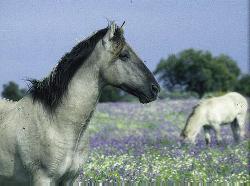 An 8 year old Sorraia stallion, main sire of one of the d'Andrade herds Photography by Hardy Oelke |
The most
disturbing factor is that no exchange of stallions is taking place. In each of
the little groups, the already incredibly strong inbreeding is intensified even
more. This holds also true for another major group which is in Germany. They -
now around forty - again go back to seven animals bought from d'Andrade's stock
and imported from Portugal in 1974 by Dr. Michael Schäfer, when the
Portuguese revolution gave rise to great concerns regarding the future of these
horses. There has been no new blood from Portugal used in that subpopulation
since! |
As an example for what is taking place, the one private Portuguese breeder outside the d'Andrade family may be mentioned: She has 5 stallions, some of which are of good type. She is using those for sports and breeds her mares to a stallion leased from the National Stud - the only exchange of blood I have witnessed. However, her mares have very little or none of the typical zebra stripes, and the stallion she leased could hardly improve on that, as he has none himself. He also has a star on his forehead and needed to be eliminated for that reason alone.
This breeder sold a colt and a filly (half siblings) to another private owner. They are of breeding age now, and the colt will breed his half sister, as those two are the only Sorraias this person owns. It would have been easy enough for him to get another stallion that is at least not a half brother to the mare, but he either sees no necessity, or doesn't care enough. The Portuguese have no problem with inbreeding whatsoever anyway. One of the d'Andrade family members had ten stallions of breeding age. One year he sold as geldings all of them but one. He, at one blow, decimated the available pool for studs by maybe a third.
Another aspect is that he of course selected the one to keep, and it might not have been the ideal one. I knew all these stallions and know that there were at least a couple which to me were of better type than the one he kept. The one he kept is more pleasing to the eye of a Lusitano breeder. Actions like that of individual breeders wouldn't be significant if a man-made breed consisting of sufficient numbers were at stake. But the Sorraia horse is too important an issue, and in a way a treasure for the whole horse world, to let its fate be decided by the whims of individual people who could decide tomorrow that they had no use for them anymore anyway and send them to the butcher - or by a National Stud that is concerned about modern breeds and their sales, has no real appreciation for the Sorraias, and keeps them only out of respect for the late Ruy d'Andrade.
Q: Would it help if more people would acquire Sorraias for their private use?
A: I guess it would on a short-term basis. At least it would increase their numbers. Quite a few Sorraias are now in private hands. Through books and articles, I've been trying to get the horse-related public aware of them. In Germany, there are - besides Schäfer - about six parties now that own breeding stock, including myself, plus I could persuade a zoological garden to keep a group of three mares and a stallion.
Some feel the Sorraia's chance for survival lies in stirring up interest among private parties and promoting them as mounts and carriage horses. This includes risks, however, as it could become counterproductive in the long run: People who are using them in the way other horses are being used will inevitably eventually change them in type and disposition. They will be breeding for what they perceive as beauty, suitability, sweet disposition, etc. They will try to cure and fix whatever soundness problems might crop up sooner or later, while Mother Nature selects differently. A wild horse doesn't have to be pretty, doesn't have to be cooperative, doesn't have to have comfortable gaits - all it needs to be able to do is survive, is finding feed, recognizing and avoiding potential danger, withstanding heat, cold, and bad weather; it needs to have qualities different from what humans like to have in a horse.
Wild horses are admired for their soundness and surefootedness, while domestic horses of whatever breed are plagued by unsoundnesses of one kind or another virtually unknown to wild ones. Whenever man intervenes and starts breeding for his goals, the soundness and other qualities which enable wild horses to survive tend to disappear.
Q: But the Sorraia can be used for riding purposes and other sports?
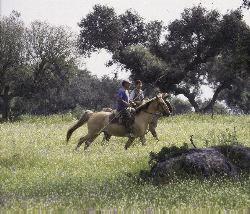 Portuguese vaqeiros (herdsmen) riding Sorraia geldings. The lance-like stick they use to prod and throw cattle with is called a pampilho. Photography by Hardy Oelke |
A: Absolutely. There have been Sorraias advanced to the highest level of dressage. They are also used herding cattle, mainly working the bull-fighting kind. Some are used as carriage horses and do well in competition. However, Sorraias aren't as uniform in their susceptibility as man-made breeds which for generations have been selected for certain traits. They have a special disposition that differs from most other horses, but their willingness to cooperate beyond a certain point differs considerably. Some are hard to tame and train, others don't pose too much of a challenge. Once a person earned their trust, it's amazing what they'll do for that person. |
But this is where I'm afraid they would lose their identity if they became more popular for domestic purposes. People would try to mate only the useful ones and inevitably lose something that belongs to the essence of these horses.
Q: In an ideal world, what could be done for the Sorraia?
A: In an ideal situation, a preserve would be created where a group of Sorraias could live wild and unmolested, without or with as little human interference as possible; where stallions again could fight about their harems, where the weak would be eliminated by Mother Nature, and where ethologists and scientists of other disciplines could do meaningful studies. Such an operation would ideally be in Portugal, or Spain, but if that were difficult to realize for some reason, it could be almost anywhere where there is enough land. With Exmoors and Polish Koniks being used in Great Britain and Holland on large tracts of land in the management of the vegetation there, it should also be possible to do something for the Sorraia - before it is too late!